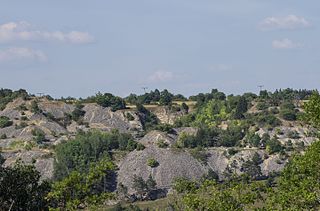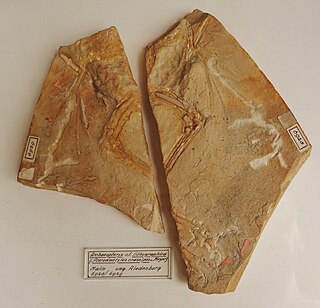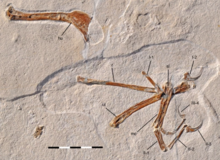
Juravenator is a genus of small coelurosaurian theropod dinosaur, which lived in the area which would someday become the top of the Franconian Jura of Germany, about 151 or 152 million years ago. It is known from a single, juvenile specimen.

Kaijiangosaurus is a genus of carnivorous tetanuran theropod dinosaur from the Middle Jurassic of China. In 1984 He Xinlu named and described the type species Kaijiangosaurus lini. The generic name refers to the River (jiang) Kai. The specific name honours the paleontologist Lin Wenqiu.

Compsognathidae is a family of coelurosaurian theropod dinosaurs. Compsognathids were small carnivores, generally conservative in form, hailing from the Jurassic and Cretaceous Periods. The bird-like features of these species, along with other dinosaurs such as Archaeopteryx inspired the idea for the connection between dinosaur reptiles and modern-day avian species. Compsognathid fossils preserve diverse integument — skin impressions are known from four genera commonly placed in the group, Compsognathus, Sinosauropteryx, Sinocalliopteryx, and Juravenator. While the latter three show evidence of a covering of some of the earliest primitive feathers over much of the body, Juravenator and Compsognathus also show evidence of scales on the tail or hind legs. "Ubirajara jubatus", informally described in 2020, had elaborate integumentary structures on its back and shoulders superficially similar to the display feathers of a standardwing bird-of-paradise, and unlike any other non-avian dinosaur currently described.

Dendrorhynchoides was a genus of anurognathid pterosaur containing only the holotype species D. curvidentatus that is known from the Middle Jurassic Tiaojishan Formation of Qinglong, northern Hebei Province, China.

Mörnsheim, or Moernsheim, is a municipality in the district of Eichstätt in Bavaria in Germany. It lies on the river Gailach and the surrounding rocks date back to the Late Jurassic (Tithonian).

Archaeorhynchus is a genus of beaked avialan stem-birds from the early Cretaceous period. A fossil of its only known species, Archaeorhynchus spathula, was first reported in 2005 by Zhou & Zhang to have been found in Yixian Formation rocks at Yixian, Liaoning province, China, showing a well-preserved and essentially complete skeleton. Two more complete specimens were found in Lower Cretaceous deposits of Jianchang, Liaoning, northeastern China, preserving new anatomical information. These deposits are 120 million years old, whereas the original specimen was 125 million years old, meaning the age range for this species is 125-120Ma.

Glacialisaurus is a genus of sauropodomorph dinosaur. It lived during the Pliensbachian stage of the Early Jurassic period around 186 to 182 million years ago in what is now the central region of the Transantarctic Mountains of Antarctica. It is known from two specimens; the holotype, a partial tarsus (ankle) and metatarsus, and a partial left femur. The fossils were collected by a team led by paleontologist William R. Hammer during a 1990–91 field expedition to the Hanson Formation of Antarctica. They were described in 2007, and made the basis of the new genus and species Glacialisaurus hammeri. The genus name translates as “icy” or "frozen lizard”, and the species name honors Hammer.

Sciurumimus is an extinct genus of tetanuran theropod from the Late Jurassic Torleite Formation of Germany. It is known from a single juvenile specimen representing the type species, Sciurumimus albersdoerferi, which was found in a limestone quarry close to Painten in Lower Bavaria. The specimen was preserved with traces of feather-like filaments.

Bellubrunnus is an extinct genus of rhamphorhynchid pterosaur from the Late Jurassic of southern Germany. It contains a single species, Bellubrunnus rothgaengeri. Bellubrunnus is distinguished from other rhamphorhynchids by its lack of long projections on the vertebrae of the tail, fewer teeth in the jaws, and wingtips that curve forward rather than sweep backward as in other pterosaurs.

The Mörnsheim Formation is a geologic formation in Germany, near Daiting and Mörnsheim, Bavaria. It preserves fossils dating back to the Jurassic period. It overlies the older Altmühltal Formation in its northwestern extent, and the Painten Formation to the east.
The Painten Formation is a geologic formation in Germany. It preserves fossils dating back to the Tithonian stage of the Late Jurassic period.

Douzhanopterus is an extinct genus of monofenestratan pterosaur from the Late Jurassic of Liaoning, China. It contains a single species, D. zhengi, named by Wang et al. in 2017. In many respects, it represents a transitional form between basal pterosaurs and the more specialized pterodactyloids; for instance, its tail is intermediate in length, still being about twice the length of the femur but relatively shorter compared to that of the more basal Wukongopteridae. Other intermediate traits include the relative lengths of the neck vertebrae and the retention of two, albeit reduced, phalanx bones in the fifth digit of the foot. Phylogenetically, Douzhanopterus is nested between the wukongopterids and a juvenile pterosaur specimen from Germany known as the "Painten pro-pterodactyloid", which is similar to Douzhanopterus in many respects but approaches pterodactyloids more closely elsewhere.

Zhongjianosaurus is a genus of dromaeosaurid belonging to the Microraptoria. Believed to hail from the Yixian Formation, specifically the middle of the Jehol Biota, it is the smallest known microraptorine thus far discovered and one of the smallest non-avian theropod dinosaurs.

Jianianhualong is a genus of troodontid theropod dinosaur from the Early Cretaceous of China. It contains a single species, Jianianhualong tengi, named in 2017 by Xu Xing and colleagues based on an articulated skeleton preserving feathers. The feathers at the middle of the tail of Jianianhualong are asymmetric, being the first record of asymmetrical feathers among the troodontids. Despite aerodynamic differences from the flight feathers of modern birds, the feathers in the tail vane of Jianianhualong could have functioned in drag reduction whilst the animal was moving. The discovery of Jianianhualong supports the notion that asymmetrical feathers appeared early in the evolutionary history of the Paraves.

Ostromia is a genus of anchiornithid theropod dinosaur from the Late Jurassic Painten Formation of Germany. The genus contains a single species, O. crassipes, named by Christian Foth and Oliver Rauhut in 2017.

Anchiornithidae is a family of small paravian dinosaurs. Anchiornithids have been classified at varying positions in the paravian tree, with some scientists classifying them as a distinct family, a basal subfamily of Troodontidae, members of Archaeopterygidae, or an assemblage of dinosaurs that are an evolutionary grade within Avialae or Paraves.

Caihong is a genus of small paravian theropod dinosaur from China that lived during the Late Jurassic period.

Fukuipteryx is an extinct genus of basal avialan dinosaurs found in Early Cretaceous deposits from Japan's Kitadani Formation. It contains one species, Fukuipteryx prima.
Yuanjiawaornis is an extinct genus of large enantiornithean bird known from the early Cretaceous of present-day China. It is monotypic, with only type species Y. virisosus known.
Cascocauda is an extinct genus of anurognathid pterosaur from the Late–Middle Jurassic Tiaojishan Formation of Hebei Province, China. The genus contains a single species, C. rong, known from a complete skeleton belonging to a juvenile individual preserved with extensive soft-tissues, including wing membranes and a dense covering of pycnofibres. Some of these pycnofibres appear to be branched, resembling the feathers of maniraptoran theropod dinosaurs, and suggesting that pterosaur pycnofibres may be closely related to feathers in dinosaurs.



























